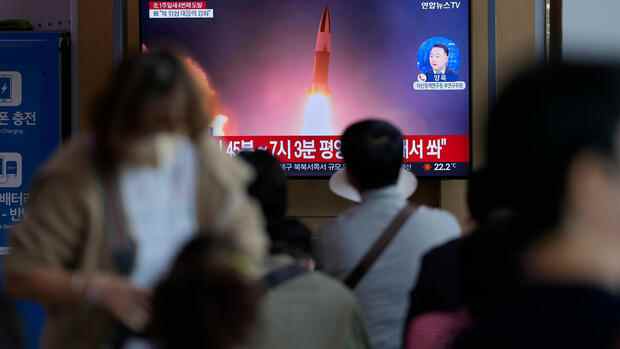Tokyo North Korea has continued the recent series of missile tests. According to the South Korean military, the ballistic missile flew towards the Sea of Japan (Korean: East Sea) on Tuesday (local time), the South Korean news agency Yonhap reported. Further details have not yet been announced.
North Korea has fired ballistic missiles 37 times this year, most recently two on Saturday. That was the fourth missile launch in a week. For the first time in five years, North Korea’s leader Kim Jong Un has ordered a missile to be fired over Japan – with the longest trajectory in North Korea’s test history.
The warhead crossed the north of Japan in near-Earth space in an easterly direction and, according to the Japanese Ministry of Defense, hit the Pacific after about 4600 kilometers.
According to expert analyses, it was a Hwasong-12 medium-range missile capable of carrying nuclear warheads. Japan’s government therefore promptly protested.
The government condemns this “outrageous act in the strongest possible terms,” said Japan’s Prime Minister Fumio Kishida in a first statement. Japan’s government immediately lodged a protest with North Korea’s embassy in China.
North Korea fires missile over Japanese territory
South Korea’s armed forces fired two precision bombs in response to the latest missile test. The Yonhap news agency, citing the South Korean military, reported that the bombs were dropped from an F-15K fighter jet over the uninhabited island of Jikdo in the Yellow Sea. In addition, flight maneuvers were held together with US F-16 fighter jets. The Yellow Sea is bordered by China and the Korean Peninsula.
Escalation expected longer
In Japan, but also in South Korea and the USA, it is particularly noticeable that North Korea is suspending its previous test protocols for the first time since 2017. The country has traditionally opposed the United Nations (UN) ban on nuclear and missile testing.
But since Kim fired rockets again in 2020 after a voluntary moratorium lasting several years, he has limited himself. North Korea’s artillery mostly only fired short-range missiles into the sea.
As was the case earlier this year, medium-range missiles were launched on very steep and high trajectories into international waters of the Sea of Japan, according to the North Korean government “out of consideration for the security of neighboring countries”.
Korea expert O’Carrol says that so far everything indicates that it was a test for political and not technical reasons,
(Photo: Reuters)
However, North Korea experts have long been expecting an escalation. Chad O’Carrol, founder of the Korea Risk Group, even warns of a seventh nuclear test just before the US congressional elections in November. After the last nuclear test in 2017, the long-term crisis on the Korean peninsula escalated to such an extent that even a war seemed possible.
O’Carrol fears a similar development. “So far, everything indicates that it was a test for political and not technical reasons,” says the Korea expert.
The test follows South Korean-US military maneuvers, the two allies’ joint anti-submarine maneuvers with Japan, the visit of the US aircraft carrier USS Ronald Reagan to South Korea, and the visit of US Vice President Kamala Harris to the region.
>> Read here: Other states are distancing themselves from Russia
In his opinion, North Korea is testing the reactions of the USA and its allies South Korea and Japan. Kim could then use possible military reactions as justification for a new nuclear test.
development is not surprising
The development is not surprising. After the failed summit diplomacy of former US President Donald Trump, North Korea did not return offers of talks, according to statements by the USA and South Korea.
Experts have long assumed that Kim has started a new cycle of escalation that cannot be easily stopped.
(Photo: Reuters)
Experts have therefore long assumed that Kim has started a new cycle of escalation that cannot be easily stopped. Because North Korea has not yet been stopped by UN sanctions.
Daniel Kritenbrink, Assistant Secretary of State for East Asian and Pacific Affairs at the US State Department, immediately urged China to do more to circumvent sanctions in Chinese coastal waters after North Korea’s test. “The failure of the People’s Republic of China and Russia to fully implement their commitments has, we fear, only encouraged the DPRK to ignore the United Nations,” the diplomat said.
A further complication is that after the outbreak of the Ukraine war, the Security Council will hardly tighten the penalties already imposed due to the veto rights of Russia and China.
Military gestures by the United States and its allies are therefore possible, South Korean President Yoon Suk-yeol indicated: “The ruthless nuclear provocation will be answered with decisive reactions from our military, our allies and the international community.” However, it is unclear what measures the governments will elect.
With agency material
More: Putin turned Russia into a nuclear rogue state – How can deterrence work there?
